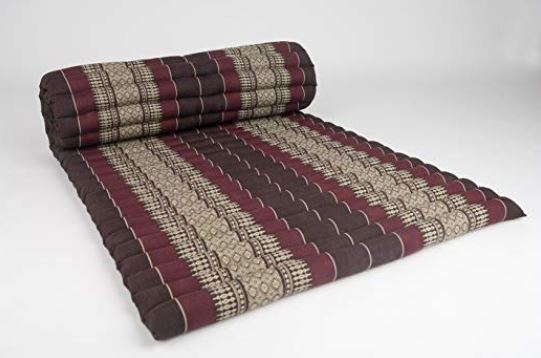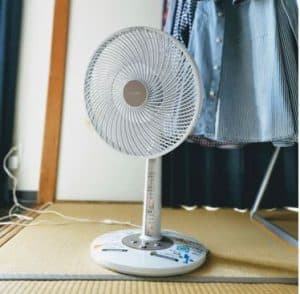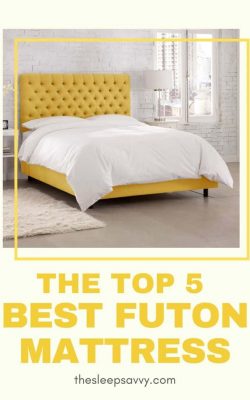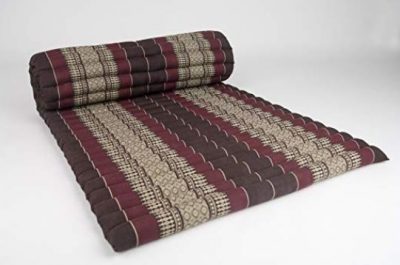We hope you love the product we recommend! Just so you know, at no extra cost to you, we may get a small commission for purchases made through links in this post. Your support is appreciated. Enjoy the read!
Sleeping on the floor? What?!
For centuries the Japanese have been sleeping on a floor mattress, called a Shikibuton (敷き布団, しきぶとん) or Futon for short.
It may sound uncomfortable, but it’s actually quite comfortable and some experts say that it’s good for your back.
Who knows, maybe that’s their secret to having the highest life expectancy in the world!
It’s one of those “you won’t know until you try” things. So, let us help you find the best futon mattress for sleeping!
Top 5 Best Futon Mattresses in 2022
| EMOOR Japanese Futon Mattress | Magshion Japanese Rolling Futon Mattress | Leewadee Roll Up Thai Futon Mattress | D&D Japanese Rolling Futon Mattress | DHP Coil Premium Futon Mattress |
|---|---|---|---|---|
 |  |  |  |  |
| Cotton & Polyester | Cotton & Foam | Natural Kapok Tree Fiber | Cotton & Polyester | Spring Coils & Memory Foam |
| 2.5″ & 15lb+ | 3″ & 11lb~ | 2″ & 8.5lb~ | 3″ & 17lb+ | 6″ or 8″ & 57lb~ |
| 7 Sizes | 4 Sizes: Twin, Full, Double & Queen | One Size: Twin | 2 Sizes: Twin & Queen | One Size: Full |
| Check Price | Check Price | Check Price | Check Price | Check Price |
| Read Review | Read Review | Read Review | Read Review | Read Review |
 |  |  |
Want to find out more about choosing the right futon for you?
Take a look at the buyer’s guide below!
Here are details of the best futon mattresses for sleeping reviews:
 EMOOR is known for their high quality, traditional style bedding products that are 100% made-in-Japan.
EMOOR is known for their high quality, traditional style bedding products that are 100% made-in-Japan.
Classe is EMOOR’s longest best-selling futon series.
This is why EMOOR Classe is our top choice:
- It’s available in 7 different sizes, includes non-standard, longer versions, including non-standard sizes to choose from.
The Full-Long (55” x 83”) futon is 4” longer than a normal Full and only weighs 15.43 pounds.
This is great for tall people or for your child going through a growth spurt. You don’t see too many non-traditional sizes out on the market, so this is a bonus.
- Although EMOOR doesn’t offer a warranty (most futon won’t come with one, so this is normal), they do have a 30-day return policy.
It’s reassuring to know that if you don’t like it, you know you can return it within a month to get your money back. That definitely gives me peace of mind.
- I like that this futon is 100% made in and shipped from Japan so it measures up to an authentic traditional futon.

This is also why it’s so lightweight and portable! At only 15 lbs, almost anyone is able to fold or roll up and store it regularly.
- The external layers are made of 100% cotton. It doesn’t come with a cover, but that’s normal too. Just like how a proper foam mattress doesn’t come with fitted bedsheets. You can easily fix that by buying or making your own cover for it.
The internal filling is 3 layers of polyester. It’s a soft quilt-hard pad-soft quilt stack to give you more comfort and cushioning.
Side Note: Quaternary ammonium salt and pyrethroid are used on 50% of the polyester wadding for 2-3 years of anti-bacterial anti-tick and deodorization effects.
Instead of just using it for overnight houseguests, the quality is high enough for you to use every day.
Pros
- Available in multiple sizes - from Twin to King and non-standard sizes
- 100% made in Japan
- Ships vacuum-sealed
- 100% polyester with 50% TEIJIN MIGHTYTOP (R) II ECO - deodorizing, anti-mite and anti-bacterial
- External fabric cover is 100% and 200 thread count
- Lightweight to fold/unfold in 3 and move around
- Fitted futon cover available for purchase
Cons
- Non-washable; use a cover and wash that instead
- No flame retardant used - so it’s flammable
- Might be slightly thinner than 2.5”
 Magshion is an US-based online home and furniture store that has been established since 2005.
Magshion is an US-based online home and furniture store that has been established since 2005.
They specialize in items from pet supplies to bedroom accessories to garden and patio items.
- At 3” thick, this model comes in 4 sizes: Single (27” x 80”), Twin (39” x 80”), Full (54” x 80”) and Queen (60” x 80”), and weighs anywhere from 11 to 28 pounds.
- The cover is 100% polyester while the internal filling is 100% cotton batting with a 0.5” thick foam layer in the middle for additional support.
- Designed to be only spot-cleaned, this roll-up foam mattress also has sewn-in straps to tie it up when not in use and is made-to-order in the USA.
Pros
- Available in 4 standard sizes
- Lightweight to carry and fold/roll
- 3” thick
- Easy, simple, basic - should meet your needs.
- Made in USA
- Made from longstanding company in USA
Cons
- Cover is not removable, spot clean only or use a fitted sheet
- Non-traditional Japanese style futon
 Leewadee Interior & More is a Thai company that specializes in making Thai-style interior items, ranging from vases to art decor to meditation mats.
Leewadee Interior & More is a Thai company that specializes in making Thai-style interior items, ranging from vases to art decor to meditation mats.
For those looking for something a bit different, check out this Thai-style floor mattress.
This multipurpose mattress is easy to roll up, measure at 79” x 30” x 2” and weighs 8.65 pounds.
When rolled up, the dimensions are 13” x 13” x 30” and there are many different Thai-style designs and colors to select from.
Made with all-natural materials, the outside cover is 100% cotton and the insides are made with a cotton-like fiber from the Kapok tree.
The mattress is tufted horizontally every few inches so the padding will forever stay in place.
Pros
- Premium double stitched seams for durability
- Many color schemes to choose from with Thai design
- Made from untreated kapok, plant fiber from a tropical tree
- Easy to roll up with sewn-in straps
- Handcrafted in Thailand
- Tufted needlework to prevent padding from shifting
- Multi-purposeful: can be used for yoga, massage, sleeping..etc.
- Shipped compressed and rolled for ease of transport
Cons
- Not a traditional futon
- 2” thick
- Handcrafted so each one is different, seams may come undone
D&D Futon Furniture is a Japanese-style bedding manufacturer that offer affordable furniture pieces with no compromise on comfort or quality.
The Rolling Bed is made in the USA, and comes in two sizes: Queen (80” x 60”) and Twin (80” x 30”).
At 3” thick, the Queen size futon weighs 28 lbs, is fire resistant and the inside is filled with 90% white cotton, 5% polyester fiber and 5% resilient foam.
Shipped compressed, you may need to stretch out the ends to get it back to its full size.
Pros
- Comes with sewn-in straps, handy to use when moving it and to tie up when not in use
- Some people even used it as their camping mattress
- Conveniently able to fold or roll
- Made in USA
- 3” thick
- Basic, simple, meets all your simple floor sleeping needs
Cons
- Only one color (black) and one size (queen)
- Potential odor some users reported
DHP, short for Dorel Home Products, is the small living space expert.
They design all household furniture like futons, mattresses, beds and dining tables.
All their products are designed with 3 main things in mind: trendy design, fit for small spaces and multi-functional.
For those who want more padding than a traditional Japanese futon, this might be the one for you!
This versatile 57-pound full size futon (75″ x 54″ x 8”) comes in a variety of color, two thickness options (6” or 8”) and two fabric cover choices (microfiber or linen) to pick from.
The internal material is made of polyester and CertiPUR-US foam with 15-gauge 522 individually wrapped spring coils.
Pros
- 8” thick
- 1-year warranty from date of purchase
- CertiPUR-US foam for health and safety
- Fire-resistant
- 522 individually-wrapped spring coils for added support
- Many options in thickness, color and fabric cover to choose from
- Versatile - can be used as couch or bed, fits all standard futon frames
- Shipped compressed and rolled for ease of transport
Cons
- Only one size - full
- Heavy - almost 60 lbs
- Heavyweights may be able to feel the springs
- Potential odor from the foam; should dissipate within a few days
- Not a traditional Japanese style futon
What are the Benefits of a Japanese Futon?
Spinal Alignment
Affordable
Great for those seeking a minimalist lifestyle or on a budget. Japanese futons are much less of a financial investment than a traditional mattress.
Space Saving
Ideal to use in a small home, a futon can transform any spaced into a bedroom in minutes.
You won’t need to buy any bulky furniture item, like a bed frame, headboard or box spring, as you would for a traditional mattress.
In the morning, you can fold and store away in the closet to make it a multi-purpose room. Ideal for people who have limited spacing or moves around a lot.
Natural Material
Back in the old days, Japanese floor futons were 100% cotton.
Today you can find other material like wool, latex, foam and even pocket coils as the filling.

Savvy Tip:
Try putting a pillow under the knees. This will reduce stress on the lower spine and promote better blood circulation. I sleep with one every night!
Buyer's Guide: What to Look For in a Japanese Futon Bed
Weight
Size
Warranty
Thickness
Internal Filling
Traditionally made from 100% cotton, old-school Japanese Shikibuton still are. Others are made with other natural material, like latex or wool with a mix of polyester.
With modern-day innovations, some are processed with substances for enhancement.
For example, some are treated for antibacterial, anti-mite and deodorizing properties. This makes the futon longer-lasting and convenient.
Usage
You may want to think about who and how often the futon will be used.
- Is it for yourself to sleep in every day or for overnight guests?
- Is your purpose to save space?
- Do you have a condition where lying on a tough surface, like the floor, is something you need?
On another note, a futon is usually used on the floor and doesn’t require any frames.
If you prefer to sleep elevated from the ground, then you may consider getting a bed frame or box spring.
Alternatively, you can build your own. Once you know the answers, they can help narrow down on your futon options.
Cover
Where It’s Made
Savvy Tip:
You may want to measure your closet or any space that you will be storing your futon during the day. Just to make sure that your new rolled-up futon can actually fit
Best Futon Mattress FAQ
Not too familiar with futons?
Check out some of the frequently asked questions below!
Why do Japanese sleep on the floor?
The Japanese way of sleeping on the floor has been a way of life for millennia.
Without getting into too much historical and cultural details, Japan is an island. There’s limited land and so homes are built smaller.
To make the most of their space, it’s practical to be able to put away something they aren’t using during the day. No bed frame, headboards or box spring means more spaces for a living!
Also, their kids can’t complain about monsters under the bed.
What is a Futon?
They used to be made of 100% cotton. Today you can find other material like wool, latex, foam and even pocket coils as the filling.
How do you clean a Japanese Futon?
To clean your Japanese futon, follow the instructions of the specific futon that you have.
If it says spot-clean only, then don’t put it in the washing machine. Some could be machine-washable.
In-between washes, you can do the following:
- Clean regularly – your floors, your room, futon covers..etc.
- Hang it out in the sun periodically to air it out – at least once a month, but once a week is better!
- Hit it with a stick while it’s airing out to fluff up the inside filling
- If you’re using it on the daily, every year you can change out the filling with new fresh material
- Careful with food, liquids and pets and children
Is sleeping on the floor good for you?
Yes, futons and hard surfaces, like on the floor, are all fine to sleep on, as long as you have enough support for proper spinal alignment.
It also comes down to your own individual preference.
What is the best thickness for a futon mattress?
In my opinion, the best thickness for a futon mattress is 2.5”.
But, of course, it depends on how firm or soft you want your futon.
Futons can come in a wide range – anything from 2” all the way up to 12” or more. Traditional Japanese-style futons are around 2-4”, whereas western futons are just thicker at 3-6”.
How long do futons last for?
Futons last longer than you think – it can span a lifetime!
If you take good care of your futon, it can last for life. Some Japanese folks have only had one futon their whole entire life.
Most do have an average lifespan of 5-7 years. Perhaps, every few years you can re-upholster the inner filling.
How can I make my futon more comfortable?
To make your futon more comfortable, dress it up like a traditional mattress!
- Too firm? Layer on a topper or padding.
- Too soft? Get rid of the futon and just sleep on the floor!
- Need more support? Get a good neck pillow, but also a body pillow for when you sleep on your sides and another pillow for under your knee when you’re sleeping on your back.
- Too cold? Layer on another blanket or use an electric heating pad
- Too hot? Leave the comforter or duvet off
Are futons better than mattresses?
A futon is not better or worse than a conventional mattress – they’re just different.
It depends on what you want and what your philosophies are. Consider the following questions:
- Have nations of people been sleeping on a thin mattress pad close to the ground for centuries? Yes.
- Are they necessarily in better shape or health? Maybe – I mean, they are known for having the longest living humans on earth…
- Do they enjoy it? Sure!
- Are you looking for a surface that conforms better for your body? Then, perhaps a futon is not what you’re looking for.
So, are futons awesome or awful? Only you can decide for yourself!
What are futons filled with?
Traditional futons are filled with multiple layers of cotton.
100% cotton futons still exist today, but they can be made of other materials like: wool, latex, foam and polyester.
Some of the fancy ones could have memory foam or innerspring coils inside as well. These would not be considered traditional Japanese futons though.
Here, watch this to see how they handmade futons!
Can you sleep on tatami mats?
Sure, you can sleep on tatami mats – why not?!
Most people don’t because it’s a bit too hard and thin, but you can do whatever you want!
Annnnnnd let’s roll it up!
Now you know which one is our top pick for the best futon mattress. Which one do you like the best?
Keep us updated and let us know how your floor sleeping experience goes!










